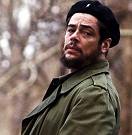|
|
||||
|
|
by Donald Levit  Many opinions floated about concerning the arrangement of Che, but director Steven Soderbergh prefers the format screened for media at the 2008 New York Film Festival: Parts 1 and 2 back-to-back around an intermission. He indicated that both the “adventure story” and the technical challenges of implementing “any large-scale political idea” grew so challenging with years of research and interviews that he, star Benicio del Toro (Che), and writer Peter Buchman opted for doing the first 131 minutes as introductory context to the originally planned, now second part about the icon’s November 1966-October 1967 Bolivian misadventure. Reminding the press that he does not espouse Marxist-Leninism as a viable economic system, even less in a non-industrial society, Soderbergh noted that Che was no fan of the arts but that this film aims to be neither politics nor art but, rather, a consideration of why the leader chose to “disappear” from Cuba and, wasted by illness, stick to his guns in a deteriorated situation doomed from the start. The idea is that the subject “found himself” in this defeat more than in other Cuban crusades of national liberation investigated by the filmmaker but discarded as taking the story far afield, e.g., the Congo, Guinea and Angola missions just documented in Jihan el Tahri’s Cuba: An African Odyssey. As far as cinema is concerned, however, the dilemma is that the real Ernesto Guevara, as distinct from the mythic figure, did not easily expose his inner workings except when doctoring the wretched of the earth. A hard disciplinarian obsessed with daily minutiae in the famous but dull Bolivian Diary, he has been Hollywoodized by the joke Che! (1969) and romanticized in The Motorcycle Diaries. The current edition, too, fails to image a being of flesh who elicits empathy. Of course, it would have been counterproductive to spend frames on love interest, and thus adoring Aleida (Catalina Sandino Moreno) and Tania (Franka Potente) are left dangling; a wife and child in Mexico (become five children in a passport photograph) are seconds of afterthought, just as are throwaway bits of a family meal and conjugal couch before he leaves for South America as “Ramón.” Opening with Fidel’s (Demián Bichir) angled television announcement of Minister of Industry Che’s resignation and unknown whereabouts, Part 1 offers faux newsreel of events following the Revolution, including Che’s verbal barbs before the United Nations General Assembly. Back, immediately, to the In between, with many printed date indications, the first part chronicles the growth in numbers and efficiency of the 26 July Movement, its agreements and differences with other anti-Batista groupings, and the triumphs as oppressors flee and Fidel emerges as supreme commandant. Action alternates between subsequent events in Why (Released by IFC Films; not rated by MPAA.) |
||
|
© 2025 - ReelTalk Movie Reviews Website designed by Dot Pitch Studios, LLC |



